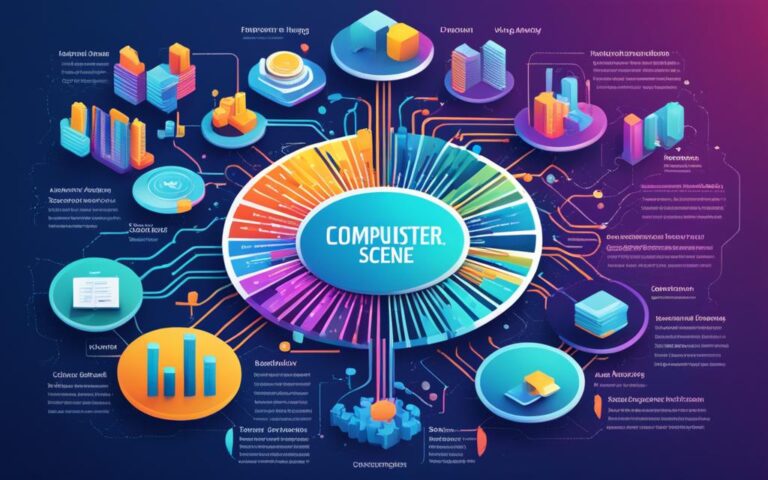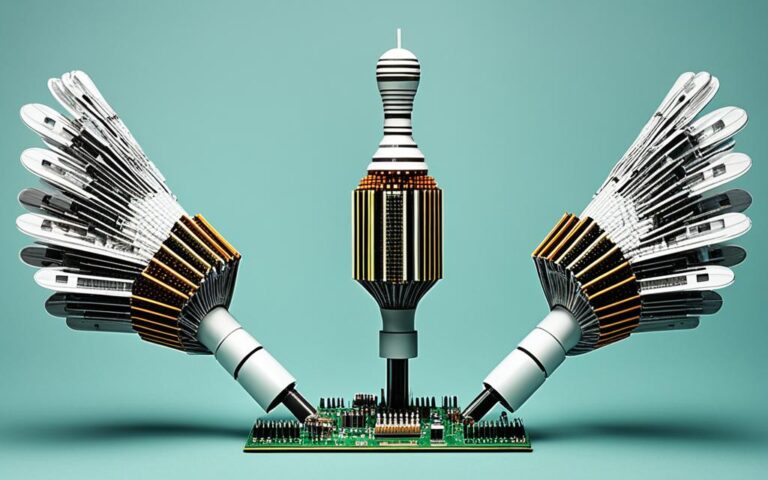The semiconductor industry is crucial in tech innovation, especially in quantum computing. It uses semiconductors, like epitaxial quantum dots, to make quantum devices and materials. Epitaxial quantum dots are tiny hetero-structures. They form by self-assembly during epitaxial growth1. This process needs very pure materials to limit defects and impurity levels1.
Another method for making quantum dots is droplet epitaxy. It involves placing certain materials on a substrate’s surface1.
Epitaxial quantum dot technology has improved a lot. It can now produce single photons quickly and efficiently1. These advances mean quantum-dot tech is nearly ready for real-world uses in quantum Internet and information processing.
Key Takeaways:
- Epitaxial quantum dots are small semiconductor hetero-structures. They’re key to creating quantum semiconductor devices and materials1.
- Droplet epitaxy is a way to make quantum dots by applying specific materials to a surface1.
- Improvements in epitaxial quantum dot tech have led to the fast and efficient production of single photons. This brings us closer to using quantum-dot technologies in real applications1.
Novel Optical Method for Embedded Quantum Semiconductor Devices
Quantum semiconductor devices are key to the progress of quantum computing. They make powerful, efficient systems for complex calculations possible. But, their success relies on the quality of the semiconductor materials. It’s crucial to protect them from electrostatic fluctuations caused by surface charges and electric noise2.
Surface gates, used in the past, have limits. They can’t create electrostatic potentials far from the surface. These gates also cause strain, leading to crystal imperfections2. Researchers now suggest a new light-based method. It uses light and photosensitive dopants to create deep electrostatic potentials2.
This new technique has many benefits. Light can get deep into the semiconductor without harming it2. It forms metastable states in a GaAs/AlGaAs quantum well. This creates steady electrostatic potentials far from the surface2.
The technique also allows forming non-planar structures without disturbing the interference patterns. This is vital for controlling quantum states and optimizing quantum operations2.
The light’s strength is adjustable by changing the light fluence on the surface. By doing this while checking Weiss commensurability oscillations, researchers can fine-tune electrostatic potentials. This boosts quantum semiconductor device performance2.
This innovative optical method paves the way for new quantum devices. It lays the groundwork for many devices in fields like microelectronics and photonics2. Lateral superlattices (LSLs) become easy and flexible platforms for tests and production2.
Methods like electron beam lithography help make LSLs. Using light to ionize Si-donors creates one- and two-dimensional LSLs in AlGaAs/GaAs structures2. This optical method has proven successful and opens up new doors for device fabrication2.
Studying light-based techniques and their impact on LSLs can advance quantum devices significantly2. With light and structured optics, researchers aim to push quantum computing further. This holds great promise for future technology development2.
Comparative Analysis of Quantum Computing Approaches
| Approach | Advantages | Challenges |
|---|---|---|
| Superconducting qubits | High coherence and scalability | Requires cryogenic cooling |
| Trapped ion qubits | Long coherence times | Complex experimental setup |
| Semiconductor-based quantum processors | Integration with microelectronics | Electrostatic fluctuations |
Here’s a quick look at various quantum computing methods. Superconducting qubits are highly coherent and scalable but need cold temperatures3. Trapped ion qubits excel in coherence time but are complex to set up3. Semiconductor processors work well with microelectronics, yet struggle with electrostatic fluctuations3.
Solid State Platform for Quantum Semiconductors
Quantum technologies are making waves in computing. Researchers are seeking new semiconductor hosts to boost computing power. They use data mining, machine learning, and expert knowledge to find these materials.
Data from various databases becomes meaningful through featurization. This info trains machine learning algorithms. Algorithms such as logistic regression predict the best materials for quantum tech4.
Machine Learning focuses on crystal aspects overlooked before. It considers symmetry and crystal structure. This new approach helps find good materials for quantum tech4.
Google and IBM have shown what solid-state quantum tech can do. Google’s quantum computer beat a supercomputer4. IBM’s quantum processor marked another leap forward4.
Quantum tech depends on quantum dots or defects, like the NV center. These defects are key for quantum communication4. They’re essential for solid-state quantum tech’s success.
A dedicated process helps identify the best semiconductor hosts for quantum tech. It blends database search with machine learning and field knowledge4. The approach has already identified 47 promising materials4.
Yet, we need more studies to fully understand these materials4.
| Data Mining and Automated Discovery Process | Machine Learning Methods | Suitable Semiconductor Hosts for Quantum Technologies |
|---|---|---|
| Targeted database search | Logistic regression | ZnGeP2 |
| Data featurization | Decision trees | CdS |
| Data mining (criteria-based) | Random forests | BP |
| Extended criteria-based approaches | Gradient boosting | BC2N |
| Empirical approaches | GeC | |
| InP |
“Solid-state quantum technologies offer exciting possibilities for the future of quantum computing. By leveraging data mining, machine learning, and targeted database search, researchers have identified potential semiconductor hosts suitable for quantum technologies. Advancements in quantum computing technology, combined with the unique characteristics of defects in semiconductor materials, further enhance the potential of solid-state quantum technologies. The development of suitable semiconductor hosts opens up new opportunities for quantum information processing and quantum communication. While the framework has generated 47 predicted candidates, further research is necessary to verify their quantum properties and advance the field of solid-state quantum technologies.”
Conclusion
Quantum computing is a big step forward in technology. It can change many industries, like the semiconductor industry(source). These computers can handle many tasks at once. This is because of their special feature called superposition5. But, this new step also comes with its own set of challenges.
Semiconductor companies see how important quantum computing is. They are spending a lot of money on research(source). They might need to change how chips are made to work with quantum computing5. Quantum processors need to be very cold to work right. Keeping them cold is hard when designing and packaging chips5. The temperatures needed make it tough, with coherence times ranging from very short to longer6.
The semiconductor industry is looking at how quantum computing can help innovate(source). The way we think about transistors and logic gates might change because of it7. Working together – schools, businesses, and governments – is key. This teamwork speeds up work on quantum and semiconductor technology7. Soon, we might use systems that mix traditional and quantum processors. This mix would use the best parts of both for certain tasks7.
In conclusion, the future of chips is closely tied to quantum computing’s growth. There are hurdles to get over, but the rewards could be huge. As quantum computing gets better, it will play a big role in developing new chips and technology. This is an exciting time for tech. Working together across different areas will lead to new discoveries. The future holds great promise, and we’re just starting to explore how quantum computing could transform the semiconductor world.
FAQ
How are semiconductors being used in the field of quantum computing?
Semiconductors, including epitaxial quantum dots, are key in developing quantum tech. They greatly help in advancing quantum computing technology.
What are epitaxial quantum dots?
Epitaxial quantum dots are tiny structures built during epitaxial growth. They’re great for making highly efficient single photons.
What is the novel method used for establishing confining electrostatic potentials within semiconductors?
A new method uses light and special dopants to create confining potentials in semiconductors. This allows light to enter without harming crystal quality. It makes it possible to create periodic potentials.
How are non-planar surface structures achieved in quantum semiconductors?
Non-planar surfaces in semiconductors come from using structured light. This method shapes surfaces with little effect on the interference patterns.
How are potential semiconductor materials for Quantum Technologies (QT) identified?
A mix of data mining, machine learning, and expert knowledge spots potential QT materials. It turns diverse data into useful features. Then, machine learning helps classify these materials for QT.
What machine learning algorithms are used in the identification of semiconductor candidates for quantum technologies?
Algorithms like logistic regression and decision trees find promising QT materials. These tools sift through databases to pinpoint semiconductor candidates.
What challenges does quantum computing pose for the semiconductor industry?
Quantum computing brings challenges like creating stable qubits and quantum software. It also might disrupt current semiconductor markets and products.
How is the semiconductor industry leveraging quantum computing technologies?
The industry is using quantum tech to spark innovation. It’s working on specialized hardware that could redefine transistors and logic gates.
Source Links
- https://www.azoquantum.com/Article.aspx?ArticleID=447 – Emerging Trends in Quantum Semiconductor Devices
- https://www.researchgate.net/publication/370735464_An_Optical_Technique_to_Produce_Embedded_Quantum_Structures_in_Semiconductors – (PDF) An Optical Technique to Produce Embedded Quantum Structures in Semiconductors
- https://www.linkedin.com/pulse/semiconductors-quantum-technologies-shashank-v-raghavan-qep5c – Semiconductors For Quantum Technologies
- https://www.nature.com/articles/s41524-022-00888-3 – Predicting solid state material platforms for quantum technologies – npj Computational Materials
- https://blog.partstat.com/the-impact-of-quantum-computing-on-the-semiconductor-industry/ – The Impact of Quantum Computing on the Semiconductor Industry
- https://semiengineering.com/quantum-computers-and-cmos-semiconductors/ – Quantum Computers And CMOS Semiconductors: A Review And Future Predictions
- https://iotbusinessnews.com/2023/12/09/04041-exploring-the-future-of-quantum-computing-and-semiconductor-technology/ – Exploring the Future of Quantum Computing and Semiconductor Technology – IoT Business News

















